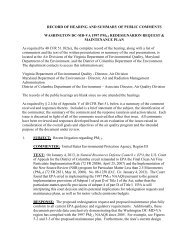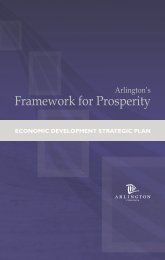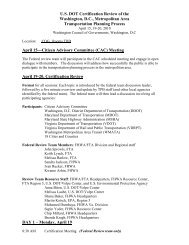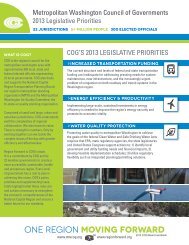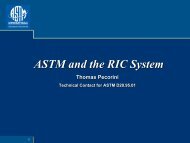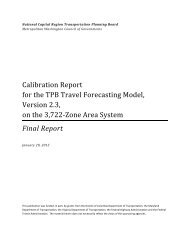PTI Local Government Energy Assurance Guidelines - Metropolitan ...
PTI Local Government Energy Assurance Guidelines - Metropolitan ...
PTI Local Government Energy Assurance Guidelines - Metropolitan ...
Create successful ePaper yourself
Turn your PDF publications into a flip-book with our unique Google optimized e-Paper software.
Contents<br />
Acknowledgements........................................................................................................................................... 1<br />
1 Introduction.................................................................................................................................................... 3<br />
1.1 Purpose of the <strong>Guidelines</strong>............................................................................................................. 3<br />
1.2 What Is <strong>Energy</strong> <strong>Assurance</strong> and Why Is It Important?..................................................................... 4<br />
1.3 <strong>Energy</strong> <strong>Assurance</strong> Challenges....................................................................................................... 5<br />
2 Issues to Consider When Developing a <strong>Local</strong> <strong>Energy</strong> <strong>Assurance</strong> Plan................................................ 7<br />
2.1 Collaborating on <strong>Local</strong> <strong>Energy</strong> <strong>Assurance</strong> Planning: Relationship Building................................. 7<br />
2.2 Taking an All-Hazards Approach.................................................................................................... 7<br />
2.3 Identifying <strong>Energy</strong> Infrastructure Interdependencies.................................................................... 8<br />
2.4 Understanding Continuity of Operations Plans........................................................................... 11<br />
2.5 Determining Information Sharing and Situational Awareness Needs......................................... 12<br />
2.6 Understanding the Impacts of New and Alternative Technologies on<br />
<strong>Energy</strong> <strong>Assurance</strong> Planning............................................................................................... 15<br />
2.6.1 The Smart Grid............................................................................................................................. 15<br />
2.6.2 Renewable <strong>Energy</strong> Technologies................................................................................................. 16<br />
2.6.3 <strong>Energy</strong> Efficiency, Distributed Generation, and <strong>Energy</strong> <strong>Assurance</strong>............................................. 20<br />
2.7 Cyber Security and <strong>Energy</strong> <strong>Assurance</strong> Planning.......................................................................... 26<br />
3 How to Develop or Enhance a <strong>Local</strong> <strong>Energy</strong> <strong>Assurance</strong> Plan............................................................. 29<br />
3.1 Introduction to the Ten-Step <strong>Local</strong>-Level Planning Framework.................................................. 29<br />
3.2 Step One: Build an <strong>Energy</strong> <strong>Assurance</strong> Response and Planning Team........................................ 29<br />
3.2.1 Designate an <strong>Energy</strong> <strong>Assurance</strong> Coordinator............................................................................. 30<br />
3.2.2 Establish an <strong>Energy</strong> <strong>Assurance</strong> Working Group.......................................................................... 31<br />
3.2.3 Build Personnel Redundancy into the Planning Framework....................................................... 35<br />
3.3 Step Two: Know the Emergency Authority Framework............................................................... 36<br />
3.4 Step Three: Understand Response Roles and Responsibilities................................................... 40<br />
3.5 Step Four: Know the <strong>Local</strong> <strong>Government</strong> <strong>Energy</strong> Profile............................................................. 45<br />
3.6 Step Five: Identify <strong>Energy</strong> Suppliers............................................................................................ 46<br />
3.6.1 <strong>Local</strong> <strong>Energy</strong> Suppliers/Infrastructure Operators and Contracts................................................. 47<br />
3.6.2 <strong>Local</strong> <strong>Energy</strong> Infrastructure/<strong>Energy</strong> Usage Characteristics.......................................................... 50<br />
3.7 Step Six: Know the Primary Contacts and Related Partners........................................................ 51<br />
3.8 Step Seven: Identify Key Assets within the Jurisdiction.............................................................. 56<br />
3.8.1 Identify the Infrastructure Providing Essential <strong>Local</strong> Services...................................................... 56<br />
3.8.2 Develop an Understanding of Existing Public and Private Sector Response Plans to<br />
Determine Which Key Assets Are Most Vulnerable to an<br />
<strong>Energy</strong> Supply Disruption or Emergency.......................................................................... 59<br />
3.9 Step Eight: Develop an <strong>Energy</strong> <strong>Assurance</strong> Crisis Communications Protocol............................. 62<br />
3.9.1 Internal Protocols/Message Coordination................................................................................... 63<br />
3.9.2 External—Communicating with the Public and the Media......................................................... 63<br />
3.10 Step Nine: Develop Additional <strong>Local</strong>, State, Regional, and<br />
Federal Partnerships for <strong>Energy</strong> <strong>Assurance</strong>...................................................................... 67<br />
3.10.1 Public Sector Partnerships........................................................................................................... 67<br />
<strong>Local</strong> <strong>Government</strong> <strong>Energy</strong> <strong>Assurance</strong> <strong>Guidelines</strong> – Version 2.0 | i



